An IoT-based Real-time Management of Energy Consumption
Águas do Tejo Atlântico (AdTA) is a major company operating in the environmental sector in Portugal. Its mission is to manage and operate the wastewater system of the Great Lisbon and West of Great Lisbon, guaranteeing the quality, continuity, and efficiency of the water public services. AdTA operates several Water Resource Recovery Facilities (WRRF). These facilities treat municipal wastewater and recover sub-products, such as bio-solids and energy. Energy consumption is the second-highest operating cost at a WRRF after labor; it can be about 50% of a utility´s total operating costs.
AdTA introduced more flexibility on its internal processes to minimize energy costs by applying a demand-side management paradigm. However, to optimize the processes, it is essential to monitor the energy consumption of the different processes and equipment in real-time. This article is related to the specific work done for real-time monitoring of the electrical energy consumption in WRRF using Internet of Things (IoT) technologies. AdTA did this work in collaboration with INOV, a Portuguese research institute.
Communication Architecture
The IoT-based communication architecture adopted considers each meter and the respective equipment connected as a “thing”. The data generated from all the things are stored in the database of a central AdTA server. The communication between the things and the server is done through the private AdTA wide area network. We have considered Wi-Fi and LoRa as two appropriate standard communication technologies for use in this application from the multiple available alternatives. Wi-Fi is a well-known technology characterized by low-cost modules for the meters, low-cost Access Point (AP), and high data rates (Mbps). As low cost is a key objective, Wi-Fi was selected. LoRa technology was also selected because it allows much higher ranges than Wi-Fi, even though we get lower data rates and higher latency than Wi-Fi. To compare the two technologies, we tested Wi-Fi in one WRRF and LoRa in another WRRF. The chosen architecture is shown in Figure 1, including both Wi-Fi and the LoRa.
The energy meters are deployed in different WRRF equipment, e.g., recirculating pumps, equalization pumps, ventilators, etc. The meters communicate to the nearest Wi-Fi AP or LoRa Gateway. The data is forwarded to an AdTA server located at the Control Centre of AdTA Headquarters (HQ) via the AdTA communication network and stored in a database. The users can access the data through a Web server or an API.
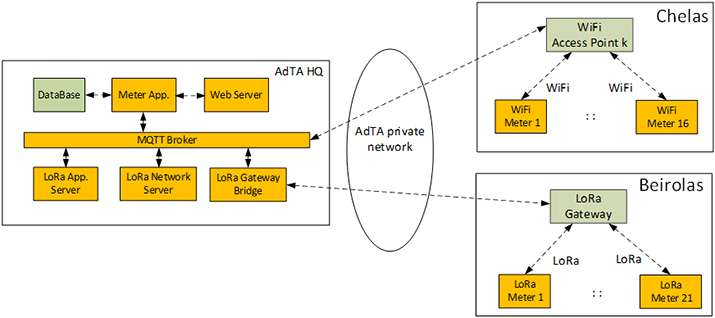
Figure 1. Wi-Fi and LoRa based communication architecture.
In the case of LoRa, a single LoRa Gateway is usually needed, while in the case of Wi-Fi, several Wi-Fi APs are needed due to its shorter communication range. For example, in Chelas WRRF, we needed five Wi-Fi APs to cover all the WRRF.
The high-level communication between an energy meter and the AdTA server uses the Message Queuing Telemetry Transport (MQTT) protocol. The energy meter contains an MQTT client and the server an MQTT broker. Periodically, e.g., every minute, the meter sends an MQTT Publish message to the MQTT broker, located in the server, with the following data: Meter ID, Voltage, Current, Power, Power Factor, Energy, Service Time, Timestamp.
Deployment and Measurement Results
Two large WRRF in the Lisbon area, located at Chelas and Beirolas, were selected for the demonstrator. Sixteen energy meters were installed in Chelas with the Wi-Fi module, while twenty one meters with the LoRa module were installed in Beirolas. The first objective was to test both communication technologies to evaluate their strong and weak aspects in a WRRF from the technical and economic points of view. The second objective was that AdTA could perform demand-side management operations in both of them: based on the real-time energy consumption of the equipment, AdTA will be able to shift loads in a controlled way so that the impact is minimized in the WRRF. Finally, to monitor the energy meters deployed in the different WRRF, a web platform was developed, allowing for viewing the main electric measured parameters.
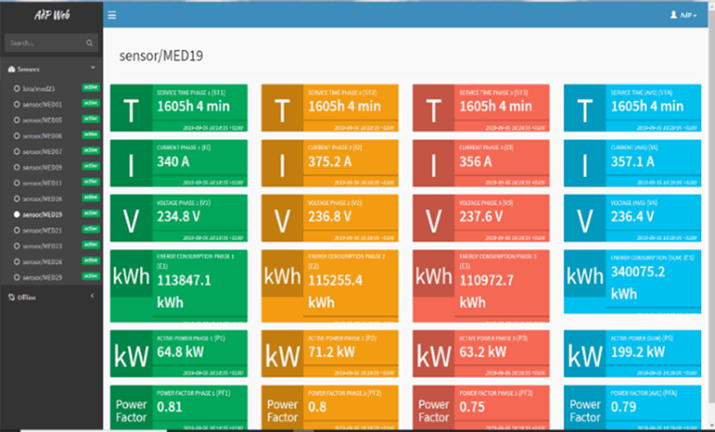
Figure 2. Monitoring web platform.
As seen in figure 2, the web platform screen shows on the left panel the meters that are online and on the right the different electrical parameters of the selected meter, namely Service Time (T), Current (I), Voltage (V), Energy (kWh), Power (kW) and Power Factor. The first three columns show the value in each phase, with the average or total value in the fourth column. The service time and energy are accumulated values; the others are instantaneous values captured when the messages are sent, typically every minute. This application also allows display, in graphical form (Figure 3, left), the angular relation between the voltage and current of each phase, which is very useful when installing the meters. Another functionality of the developed application is to allow the calculation of the Discrete Fourier Transform of the voltage and current, to calculate the respective harmonics. In the example presented in Figure 3 on the right, we can see the harmonic content of the current.

Figure 3. Left: polar graphic of voltage and current angles. Right: current harmonics.
Conclusion
The evaluation of both Wi-Fi and LoRa technologies proved satisfactory for the WRRF environment, although Wi-Fi allows shorter intervals to make the measurements due to the higher data rate. On the other hand, the LoRa network is more straightforward to deploy in a WRRF than the Wi-Fi. For future deployments in other WRRF, any of those two technologies is technically adequate for real-time energy measurement and energy management operations, and the respective cost will be an important factor for the decision. From the webserver where the data is stored and with a special purpose application developed, we could perform data analytics on the collected data.
References
- Póvoa, P., Oehmen, A., Inocêncio, P., Matos, J.S., Frazão, A., Modelling energy costs for different operational strategies of a large Water Resource Recovery Facility. Water Science Technology, May 2017.
- R. Alves, M. Nunes, A. Casaca, P. Póvoa, J. Botelho, “Real-time Management of Energy Consumption in Water Resource Recovery Facilities Using IoT Technologies”, Chapter on Book “Internet of Things – The Call of the Edge - Everything Intelligent Everywhere”, River Publishers Series on Communications”, October 2020.
 Rita Lourinho, M.Sc. in Environmental Engineering, New University of Lisbon, Portugal. She works in the water and sanitation sector since 2000. Presently, she is the Leader of the Research, Development and Innovation department at AdTA.
Rita Lourinho, M.Sc. in Environmental Engineering, New University of Lisbon, Portugal. She works in the water and sanitation sector since 2000. Presently, she is the Leader of the Research, Development and Innovation department at AdTA.
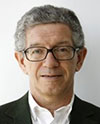 Augusto Casaca, Ph.D. in Computer Science, University of Manchester, UK. Full professor at Instituto Superior Técnico, University of Lisbon, Portugal. Senior researcher at INOV and INESC-ID. His research interests are in communication systems and design of IoT vertical applications. He is an IEEE Life Senior member.
Augusto Casaca, Ph.D. in Computer Science, University of Manchester, UK. Full professor at Instituto Superior Técnico, University of Lisbon, Portugal. Senior researcher at INOV and INESC-ID. His research interests are in communication systems and design of IoT vertical applications. He is an IEEE Life Senior member.
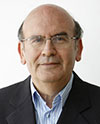 Mário Nunes, PhD in Electronics and Computer Engineering, and Aggregation degree in the same area, Instituto Superior Técnico, University of Lisbon, Portugal. Full Professor at Instituto Superior Técnico. Group leader at INOV in the areas of IoT and Wireless Communications. He is an IEEE Senior member.
Mário Nunes, PhD in Electronics and Computer Engineering, and Aggregation degree in the same area, Instituto Superior Técnico, University of Lisbon, Portugal. Full Professor at Instituto Superior Técnico. Group leader at INOV in the areas of IoT and Wireless Communications. He is an IEEE Senior member.
 Nicole Feliciano, M.Sc. in Environmental and Energy Engineering, ESTG Leiria, Portugal. She works in the water and sanitation sector since 2013. Presently, she is Supervisor of the energy management area at AdTA.
Nicole Feliciano, M.Sc. in Environmental and Energy Engineering, ESTG Leiria, Portugal. She works in the water and sanitation sector since 2013. Presently, she is Supervisor of the energy management area at AdTA.
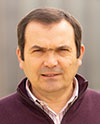 José Botelho, Electrical Engineer, FCTUC, Coimbra, Portugal. He has focused his work into the project and implementation of electrical installations, and he is in the water sector since 2006. Presently, he is responsible for the energy management area in AdTA.
José Botelho, Electrical Engineer, FCTUC, Coimbra, Portugal. He has focused his work into the project and implementation of electrical installations, and he is in the water sector since 2006. Presently, he is responsible for the energy management area in AdTA.
Sign Up for IoT Technical Community Updates
Calendar of Events
IEEE 8th World Forum on Internet of Things (WF-IoT) 2022
26 October-11 November 2022
Call for Papers
IEEE Internet of Things Journal
Special issue on Towards Intelligence for Space-Air-Ground Integrated Internet of Things
Submission Deadline: 1 November 2022
Special issue on Smart Blockchain for IoT Trust, Security and Privacy
Submission Deadline: 15 November 2022
Past Issues
September 2022
July 2022
March 2022
January 2022
November 2021
September 2021
July 2021
May 2021
March 2021
January 2021
November 2020
July 2020
May 2020
March 2020
January 2020
November 2019
September 2019
July 2019
May 2019
March 2019
January 2019
November 2018
September 2018
July 2018
May 2018
March 2018
January 2018
November 2017
September 2017
July 2017
May 2017
March 2017
January 2017
November 2016
September 2016
July 2016
May 2016
March 2016
January 2016
November 2015
September 2015
July 2015
May 2015
March 2015
January 2015
November 2014
September 2014


